Do you have a question about the Siemens iQ500 KU Series and is the answer not in the manual?
| Number of Doors | 2 |
|---|---|
| Defrost System | Frost Free |
| Climate Class | SN-T |
| Noise Level | 39 dB |
| Height | 1772 mm |
| Refrigerator Capacity | 279 liters |
Provides general information about the manual, intended use, and user restrictions for safe operation.
Details safety instructions for transporting the appliance, warning about potential injury due to its weight.
Outlines essential safety guidelines for installing the appliance, including electrical connection precautions.
Covers safe appliance operation and highlights risks of suffocation from packaging materials and small parts.
Addresses potential hazards like explosion, fire, injury, and cold burns, along with necessary precautions.
Covers health risks from food contamination and provides instructions for handling damaged appliances.
Details fire prevention measures and safety procedures if refrigerant tubes are damaged.
Provides instructions on how to save energy during installation and daily use of the appliance.
Lists all components included in the appliance delivery and how to check for damage or missing items.
Outlines the steps for proper installation and electrical connection of the appliance.
Specifies requirements for the installation location, including ventilation and ambient temperature suitability.
Guides on initial steps before using the appliance, including cleaning and removing protective materials.
Details how to correctly connect the appliance to the power supply for initial operation.
Describes how to adjust shelves and use pull-out and fruit/vegetable containers.
Explains the functions of the main switch, Super freezing control, and temperature display for operation.
Details adjusting door racks and using accessories like egg tray, bottle holder, and ice cube tray.
Provides step-by-step instructions for turning the appliance on and off using the main switch.
Offers advice for initial use and how to set the desired temperature for the refrigerator compartment.
Explains how to set the freezer compartment temperature, influenced by the refrigerator setting.
Details how to activate Super freezing for rapid cooling and its effects on operation and noise.
Describes the different temperature zones within the refrigerator compartment and their recommended usage.
Explains the 'OK' sticker for checking correct refrigerator temperature for food safety and quality.
Emphasizes keeping the freezer compartment door closed to prevent thawing and ice buildup.
Informs about the appliance's maximum freezing capacity and where this information can be found.
Provides advice on selecting quality frozen food, checking packaging, best-before dates, and temperature.
Offers guidance on how to store food efficiently in the freezer compartment for optimal preservation.
Gives recommendations on preparing and freezing fresh food to preserve nutritional value, flavour, and colour.
Lists foods suitable and unsuitable for freezing and provides guidance on proper packaging materials.
Details recommended storage times for various foods frozen at -18 °C to maintain quality.
Explains different methods for defrosting food to maintain product quality and ensure safety.
Explains the automatic defrosting process in the refrigerator compartment and maintenance tips for condensation.
Provides step-by-step instructions for manually defrosting the freezer compartment to maintain efficiency.
Outlines the necessary steps to prepare the appliance before cleaning, including power disconnection.
Details how to clean the appliance safely and effectively, warning against improper methods and products.
Instructions for regularly cleaning the condensation channel and drainage hole to ensure proper drainage.
Guides on how to remove and clean the ventilation grille for optimal air circulation and appliance performance.
Explains how to remove shelves, racks, and containers for thorough cleaning and maintenance.
Lists common appliance faults, their causes, and troubleshooting steps for resolution.
Addresses issues with incorrect temperature settings and provides diagnostic steps for resolution.
Explains common appliance noises and whether they indicate a fault or normal operation.
Provides steps to identify and resolve unpleasant smells within the appliance by cleaning and proper storage.
Instructions on how to properly switch off and prepare the appliance for periods of non-use or storage.
Guidance on environmentally friendly disposal of the appliance, adhering to WEEE guidelines.
Information on how to contact Customer Service for queries, troubleshooting, and repairs.
Explains where to find the product (E-Nr.) and production (FD) numbers for service inquiries and warranty.

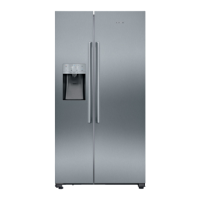
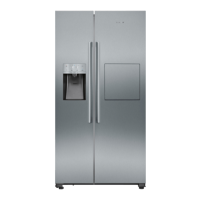
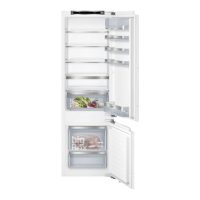

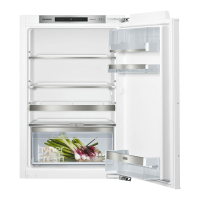
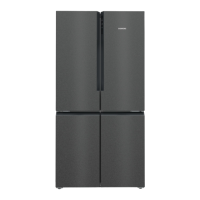

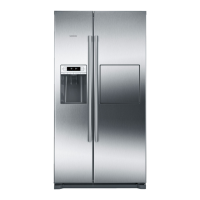
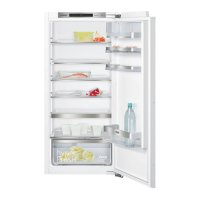
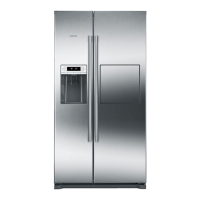
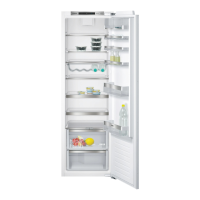
